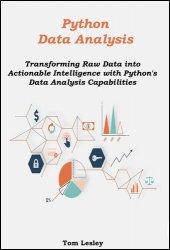 Название: Python Data Analysis: Transforming Raw Data into Actionable Intelligence with Python's Data Analysis Capabilities
Название: Python Data Analysis: Transforming Raw Data into Actionable Intelligence with Python's Data Analysis CapabilitiesАвтор: Tom Lesley
Издательство: May Reads
Год: 2024
Язык: английский
Формат: pdf, azw3, epub, mobi
Размер: 10.1 MB
Python has emerged as a powerful language for data analysis, thanks to its extensive libraries and ease of use. Python for Data Analysis is a comprehensive guide that will help beginners and experienced professionals learn how to use Python for data analysis.
This book covers everything from the basics of Python programming to advanced topics like Machine Learning, Deep Learning, and Bayesian data analysis. The book begins by introducing readers to the basics of Python programming and the key data structures used in data analysis. It then covers the various data preparation and exploratory data analysis techniques that are commonly used in the field.
The book also covers advanced topics like Machine Learning, where readers will learn about regression, classification, clustering, and dimensionality reduction techniques. The book also includes a chapter on natural language processing (NLP), where readers will learn about text classification, sentiment analysis, and topic modeling.
In addition, the book covers big data analytics, where readers will learn how to use distributed computing frameworks like PySpark and Dask to handle large datasets. The book also covers cloud-based platforms like AWS and Google Cloud, where readers will learn how to scale their Python code to handle big data analysis tasks.
The book concludes with a chapter on advanced topics like deep learning, reinforcement learning, and Bayesian data analysis. Readers will also learn about advanced visualization techniques that can help them present their findings in a clear and concise manner.
Easy-to-learn syntax Python's syntax is simple, readable, and easy to learn, even for those without programming experience. The code is written in plain English, making it easy to understand and debug. Python has a minimalist approach to syntax, making it easier to read and write code.
Abundance of libraries Python has a broad range of libraries designed to handle data analysis tasks, such as data cleaning, data visualization, Machine Learning, and statistics. Some of the most popular libraries for data analysis include NumPy, Pandas, Matplotlib, Seaborn, SciPy, and Scikit-Learn.
Large-scale data processing Python is capable of handling large-scale data processing, thanks to libraries like Dask, PySpark, and Ray. These libraries provide parallel computing capabilities, making it possible to scale up data processing to handle large datasets.
Whether you are a beginner or an experienced professional, Python for Data Analysis is an essential guide for anyone who wants to learn how to use Python for data analysis. With clear explanations, practical examples, and hands-on exercises, this book will help you master the skills needed to become a successful data analyst.
Скачать Python Data Analysis: Transforming Raw Data into Actionable Intelligence with Python's Data Analysis Capabilities